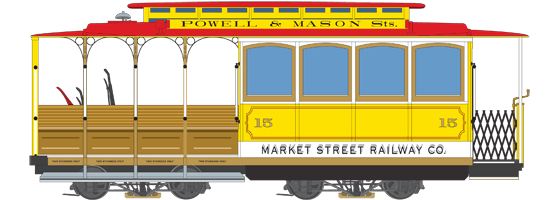This striking yellow cable car displays the livery that Powell-Mason cable cars wore from 1893 to around 1905. It was recreated with help from our non-profit group.
 Mayor Gavin Newsom and SFMTA CEO Nathaniel Ford cut the ribbon on no. 15.
Mayor Gavin Newsom and SFMTA CEO Nathaniel Ford cut the ribbon on no. 15.Over the decades, there have been several organizations named “Market Street Railway,” currently the name of Muni’s non-profit preservation partner (which is not related to any of its transit operator predecessors).
This Market Street Railway was formed in 1893 by interests from the Southern Pacific Railroad, a politically dominant company in the California of that day, later vilified in Frank Norris’s famous novel The Octopus.
Among its other acquisitions was the Ferries & Cliff House Railway, which included the Powell Street cable car operations. In that day, the lines that ran from the company’s Washington-Mason powerhouse and carbarn included, among others, the Powell-Mason and the Powell-Jackson (later called Washington-Jackson), which started at Powell and Market and then ran east-west on Washington and Jackson Streets to reach Pacific Heights. (The Powell-Hyde line was not created until 1957 as part of a consolidation and reduction in cable car service.)
The Market Street Railway Company of 1893 dedicated a specific fleet of color-coded cars to each line. For example, among its Market Street cable car lines, the cars that continued out Haight Street were painted red, Hayes Street green, Valencia Street blue, and Castro Street white. The Powell-Mason cable cars were painted yellow with red trim.
When United Railroads took over the Powell Street cable lines in 1902, they initially left the cable cars in their line-by-line different colored liveries, simply painting “United Railroads” on the side owner’s panels. This yellow livery disappeared from the Powell-Mason cable cars by 1905, but has now returned on cable car No. 15, which was constructed virtually from scratch by Muni crafts workers to enter service in 2009.
This piece of 21st century craftsmanship is a fitting tribute to the 19th century Powell-Mason line, which today is the oldest surviving transit line in America still operating its original route with its original type of equipment.
Powell Street Cable Car Specifications
Number of Cars
28 on roster (Maximum of 19 in service at one time)
Capacity
60 (29 seated + 31 standing)
Weight
15,500 lb (7,030 kg)
Length
27′ 6″ (8.4 m)
Height
10′ 5″ (3.2 m)
Width
8′ 0″ (2.4 m)
Track Gauge
3′ 6″ (1.07 m)
Round Trip Route Length
Powell-Mason line: 3.2 mi (5.15 km)
Powell-Hyde line: 4.3 mi (6.92 km)
Cable Speed
9.5 mph (15.3 km/h)
Cable Lengths
Powell: 9,300 ft (2,835 m)
Mason: 10,300 ft (3,140 m)
Hyde: 16,000 ft (4875 m)
Cable Motive Power
510-horsepower electric motor driving four cable winders at powerhouse
Powerhouse and Carbarn
Washington and Mason Streets
Built 1887 by Ferries & Cliff House Railway
Rebuilt 1906 by United Railroads
Rebuilt 1982-84 by San Francisco Municipal Railway
Steepest Grades on Powell Lines
Powell: 17% between Bush & Pine
Mason: 17% between Union & Green
Hyde: 21% between Bay & Chestnut
